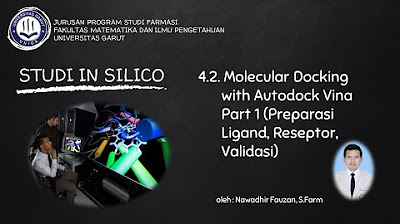Tutorial Molecular Docking dan Mendapatkan Energi HOMO-LUMO
Summary
TLDRThis video tutorial provides a step-by-step guide on protein docking, focusing on the preparation and analysis of protein structures. It explains how to download 3D structures, remove unnecessary atoms, and adjust the software settings for accurate docking results. The process includes protein structure modification, docking preparation using Discovery Studio, and visualizing interaction diagrams. It also covers energy calculations for optimal binding affinity using tools like Autodock and Goian software. The tutorial is aimed at helping users perform protein-ligand docking and analyze the results with precision and clarity.
Takeaways
- 😀 Download the 3D structure of the protein from a reliable website (e.g., PDB for protein and Arur Meron for 3D conformers).
- 😀 Save the downloaded files in appropriate formats such as PDB for protein structures and SDF for ligands.
- 😀 Open the files in Discovery Studio and use keyboard shortcuts (Ctrl+H) to access the hierarchy of the protein structure.
- 😀 Remove hetero atoms (non-protein atoms) by selecting and deleting them in Discovery Studio to prepare for docking.
- 😀 Add hydrogen atoms to the structure in Discovery Studio for better docking accuracy.
- 😀 Focus on a specific chain (e.g., chain A) and remove other chains from the structure to simplify the docking process.
- 😀 Use Discovery Studio to perform docking preparation, adjusting settings to save the docking file and examine binding affinity.
- 😀 Ensure correct format for ligand coordinates, replacing commas with dots in the software to avoid errors during docking.
- 😀 Use AutoDock Vina for docking simulations and analyze the results based on the binding affinity scores.
- 😀 After docking, visualize interactions in 2D to understand the molecular binding between the ligand and protein.
- 😀 Calculate HOMO (Highest Occupied Molecular Orbital) and LUMO (Lowest Unoccupied Molecular Orbital) energies using Gaussian software to assess molecular properties.
Q & A
What is the first step in the docking process as described in the script?
-The first step involves downloading the 3D structure of the target protein from a website. In the example provided, the protein with the code 8j2p, associated with a type of blood cancer, is used.
How should the protein structure be saved after downloading?
-After downloading the protein structure, it should be saved in the PDB format.
What is the purpose of downloading the ligand from the website?
-The ligand is downloaded to perform docking simulations. The ligand's 3D structure is saved in the SDF format.
What software is used to open the downloaded protein and ligand files?
-The downloaded files are opened using Discovery Studio software.
What should be done after opening the protein file in Discovery Studio?
-After opening the protein file, the user should delete the hetero atoms, which are irrelevant for the docking process.
What is the significance of deleting a specific chain (e.g., chain B) in the protein structure?
-Deleting chains other than the one where docking is focused (such as chain A) is important to ensure that the docking process concentrates only on the relevant chain and not the entire protein.
What action is performed after preparing the protein structure for docking?
-After preparing the protein structure by removing unnecessary chains and atoms, the next step is to perform docking preparation using the 'Do' tool in Discovery Studio.
How is the ligand’s coordinates handled in the docking process?
-The ligand’s coordinates are copied and modified by changing commas to periods, as the software cannot read coordinates in the comma format. The ligand's size is also adjusted to 30x30x30.
What is the goal of calculating the binding affinity in the docking process?
-The goal of calculating the binding affinity is to assess how well the ligand binds to the target protein. A lower binding affinity (below 2) indicates a better binding interaction.
What does the 2D interaction diagram represent in the docking process?
-The 2D interaction diagram visually represents the binding interactions between the protein and the ligand, showing specific bonds and interactions in the docking simulation.
How can the HOMO and LUMO energies be calculated during the process?
-HOMO and LUMO energies can be calculated using the Gaussian software by selecting the appropriate settings, including the DFT method and basis set. After running the calculations, the results are displayed, showing the electronic energies for HOMO and LUMO.
Outlines

Cette section est réservée aux utilisateurs payants. Améliorez votre compte pour accéder à cette section.
Améliorer maintenantMindmap

Cette section est réservée aux utilisateurs payants. Améliorez votre compte pour accéder à cette section.
Améliorer maintenantKeywords

Cette section est réservée aux utilisateurs payants. Améliorez votre compte pour accéder à cette section.
Améliorer maintenantHighlights

Cette section est réservée aux utilisateurs payants. Améliorez votre compte pour accéder à cette section.
Améliorer maintenantTranscripts

Cette section est réservée aux utilisateurs payants. Améliorez votre compte pour accéder à cette section.
Améliorer maintenantVoir Plus de Vidéos Connexes

Molecular Docking Tutorial: AUTODOCK VINA - PART 2 | Beginners to Advanced

PRAKTIKUM BIOKIMIA - PENENTUAN KADAR PROTEIN DENGAN METODE BIURET

Pemeriksaan Total Protein Darah

4.2. Molecular Docking with Autodock Vina Part 1 (Preparasi Ligand, Reseptor, Validasi)

Determination of Crude Protein Content (Part-1)_A Complete Procedure (AOAC 2001.11)

Western Blot - Theory and method
5.0 / 5 (0 votes)
